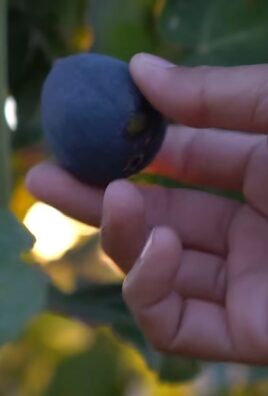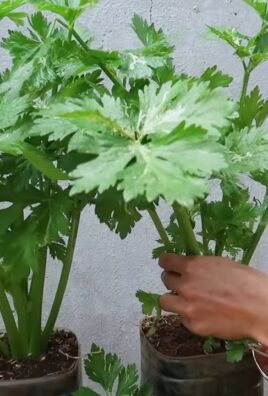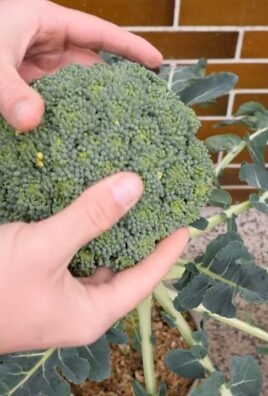Grow Strawberries Indoors? Absolutely! Imagine plucking juicy, red strawberries fresh from your own indoor garden, even in the dead of winter. Sounds like a dream, right? Well, it’s a dream within reach! For centuries, humans have cultivated plants indoors, from the hanging gardens of Babylon to the humble windowsill herb gardens of today. But bringing the taste of summer indoors, specifically with strawberries, feels extra special.
I know what you’re thinking: “Strawberries need sunshine!” And while they certainly thrive outdoors, with a few clever tricks and a little DIY ingenuity, you can successfully grow strawberries indoors and enjoy their deliciousness year-round. This isn’t just about having a pretty plant; it’s about fresh, healthy snacks at your fingertips, reducing your grocery bill, and connecting with nature, no matter the weather. Plus, who wouldn’t love the bragging rights of growing their own strawberries indoors?
This article is packed with easy-to-follow DIY hacks and tips that will guide you through every step of the process, from choosing the right variety to troubleshooting common problems. So, grab your gardening gloves, and let’s get started on your indoor strawberry adventure!

Growing Strawberries Indoors: A Sweet DIY Project
Hey there, fellow plant enthusiasts! Ever dreamt of picking fresh, juicy strawberries right from your kitchen in the dead of winter? Well, dream no more! Growing strawberries indoors is totally achievable, and I’m here to guide you through the whole process. It might seem daunting, but trust me, with a little patience and the right setup, you’ll be enjoying homegrown strawberries in no time. Let’s get started!
What You’ll Need
Before we dive into the nitty-gritty, let’s gather our supplies. Here’s a checklist of everything you’ll need to create your indoor strawberry paradise:
* Strawberry Plants: You can start with bare-root plants, runners, or even established plants from a nursery. Day-neutral or everbearing varieties are best for indoor growing as they produce fruit continuously throughout the season. Some popular choices include ‘Albion,’ ‘Seascape,’ and ‘Tristar.’
* Containers: Choose pots that are at least 6-8 inches in diameter. Hanging baskets, window boxes, or even repurposed containers work great! Just make sure they have drainage holes.
* Potting Mix: Use a high-quality, well-draining potting mix. Avoid using garden soil, as it can compact and hinder drainage. A mix specifically formulated for fruits and vegetables is ideal.
* Grow Lights: Strawberries need a lot of light to produce fruit. Invest in a good set of grow lights, preferably LED, that can provide at least 12-16 hours of light per day.
* Fertilizer: A balanced, water-soluble fertilizer formulated for strawberries is essential for providing the necessary nutrients.
* Watering Can or Spray Bottle: For watering your plants.
* Small Brush or Cotton Swab: For hand-pollinating your strawberry flowers.
* Optional: A humidity tray or humidifier to increase humidity levels.
Choosing the Right Strawberry Variety
Not all strawberries are created equal, especially when it comes to indoor growing. As I mentioned earlier, day-neutral and everbearing varieties are your best bet. These types don’t rely on specific day lengths to trigger flowering and fruiting, making them perfect for the controlled environment of your home.
* Day-Neutral Varieties: These varieties produce fruit continuously throughout the growing season, regardless of day length. ‘Albion’ and ‘Tristar’ are excellent choices.
* Everbearing Varieties: These varieties produce two or three main crops of strawberries per year, typically in the spring, summer, and fall. ‘Seascape’ is a popular everbearing variety.
Avoid June-bearing varieties, as they require specific day lengths and temperature fluctuations to produce fruit, making them less suitable for indoor growing.
Planting Your Strawberries
Okay, now for the fun part – planting! Here’s how to get your strawberry plants settled into their new indoor homes:
1. Prepare Your Containers: Fill your chosen containers with the potting mix, leaving about an inch of space at the top.
2. Planting Bare-Root Strawberries: If you’re starting with bare-root plants, soak the roots in water for about an hour before planting. This will help rehydrate them. Dig a small hole in the potting mix, large enough to accommodate the roots. Gently spread the roots out and place the plant in the hole, ensuring that the crown (the point where the roots meet the stem) is level with the soil surface. Backfill the hole with potting mix and gently firm the soil around the plant.
3. Planting Runners or Established Plants: If you’re using runners or established plants, carefully remove them from their original containers. Gently loosen the roots and plant them in the prepared containers, ensuring that the top of the root ball is level with the soil surface. Backfill the hole with potting mix and gently firm the soil around the plant.
4. Water Thoroughly: After planting, water your strawberry plants thoroughly until water drains out of the drainage holes. This will help settle the soil and ensure that the roots are well-hydrated.
Providing the Right Environment
Strawberries are pretty adaptable, but they do have some specific needs when it comes to their environment. Here’s how to create the perfect indoor growing conditions:
1. Light: This is arguably the most crucial factor. Strawberries need at least 12-16 hours of light per day to produce fruit. Place your plants under grow lights, ensuring that the lights are positioned about 6-12 inches above the plants. Adjust the height of the lights as the plants grow. If you don’t have grow lights, you can try placing your plants near a sunny south-facing window, but you’ll likely need to supplement with artificial light, especially during the winter months.
2. Temperature: Strawberries thrive in temperatures between 60-80°F (15-27°C). Avoid placing your plants near drafts or heating vents, as extreme temperature fluctuations can stress them.
3. Humidity: Strawberries prefer moderate humidity levels, around 50-60%. If your home is particularly dry, you can increase humidity by placing a humidity tray filled with water near your plants or using a humidifier.
4. Air Circulation: Good air circulation is essential for preventing fungal diseases. Ensure that your plants have adequate space between them and that there’s some airflow in the room. A small fan can help improve air circulation.
Watering and Fertilizing
Proper watering and fertilization are crucial for healthy growth and abundant fruit production.
1. Watering: Water your strawberry plants regularly, keeping the soil consistently moist but not waterlogged. Check the soil moisture by sticking your finger about an inch into the soil. If it feels dry, it’s time to water. Avoid overwatering, as this can lead to root rot. Water at the base of the plant, avoiding wetting the foliage, to prevent fungal diseases.
2. Fertilizing: Feed your strawberry plants with a balanced, water-soluble fertilizer formulated for strawberries every 2-3 weeks during the growing season. Follow the instructions on the fertilizer package for proper dilution rates. Avoid over-fertilizing, as this can burn the roots.
Pollinating Your Strawberries
Since you’re growing your strawberries indoors, you’ll need to play the role of the bees and hand-pollinate your flowers. Don’t worry, it’s easier than it sounds!
1. Hand-Pollination: Once your strawberry plants start to flower, use a small brush or cotton swab to gently transfer pollen from one flower to another. Gently brush the pollen from the stamen (the male part of the flower) onto the pistil (the female part of the flower). Repeat this process for all the flowers on your plants. You can also use a small fan to gently blow air around the plants, which can help distribute the pollen.
2. Timing: Pollinate your flowers in the morning, when the pollen is most viable. Repeat the pollination process every few days to ensure that all the flowers are pollinated.
Dealing with Pests and Diseases
Even indoors, your strawberry plants can be susceptible to pests and diseases. Here’s how to keep them healthy:
1. Pests: Common indoor strawberry pests include aphids, spider mites, and whiteflies. Inspect your plants regularly for signs of infestation, such as small insects, webbing, or sticky residue. If you find pests, you can try washing them off with a strong stream of water or using an insecticidal soap or neem oil.
2. Diseases: Common strawberry diseases include powdery mildew and gray mold. These diseases are often caused by poor air circulation and high humidity. To prevent diseases, ensure that your plants have adequate space between them and that there’s good airflow in the room. Avoid wetting the foliage when watering and remove any infected leaves or fruit. You can also use a fungicide if necessary.
Harvesting Your Strawberries
The moment you’ve been waiting for! Harvesting your homegrown strawberries is the most rewarding part of the process.
1. Ripeness: Strawberries are ready to harvest when they are fully red and slightly soft to the touch. Gently twist the strawberry off the plant, leaving a small piece of the stem attached.
2. Timing: Harvest your strawberries in the morning, when they are at their peak flavor.
3. Storage: Freshly harvested strawberries are best eaten immediately. If you need to store them, place them in a single layer in a container lined with paper towels and refrigerate them for up to a few days.
Troubleshooting
Even with the best care, you might encounter some challenges along the way. Here are some common problems and how to fix them:
* No Fruit Production: This could be due to insufficient light, improper pollination, or lack of nutrients. Ensure that your plants are getting enough light, hand-pollinate your flowers regularly, and fertilize them with a balanced fertilizer.
* Yellowing Leaves: This could be due to overwatering, underwatering, or nutrient deficiencies. Check the soil moisture and adjust your watering accordingly. Fertilize your plants with

Conclusion
So, there you have it! Growing strawberries indoors might seem like a whimsical dream, but with a little know-how and a touch of patience, you can enjoy the sweet taste of homegrown berries year-round. This DIY trick isn’t just about having fresh fruit at your fingertips; it’s about connecting with nature, learning a new skill, and experiencing the satisfaction of nurturing something from seed to harvest.
Why is this a must-try? Because it empowers you to control the quality and source of your food. No more worrying about pesticides or long-distance transportation. You’ll have plump, juicy strawberries bursting with flavor, grown right in your own home. Plus, it’s a fantastic conversation starter and a unique way to add a touch of green to your living space.
But don’t stop there! Experiment with different strawberry varieties to find your favorite. Try alpine strawberries for their intense flavor or everbearing varieties for a continuous harvest. Consider using different containers, from hanging baskets to vertical planters, to maximize your space and create a stunning display. You can even explore hydroponic systems for a more advanced and efficient growing method.
Remember, the key to success is providing your indoor strawberries with the right conditions: ample light, well-draining soil, and consistent watering. Don’t be afraid to adjust your approach based on your environment and the needs of your plants.
We wholeheartedly encourage you to give this DIY trick a try. It’s a rewarding experience that will bring joy and deliciousness to your life. And most importantly, we want to hear about your journey! Share your successes, your challenges, and your tips in the comments below. Let’s create a community of indoor strawberry growers and learn from each other. Let us know what you think of our guide to grow strawberries indoors. Your experiences will inspire others to embark on this delightful adventure. Happy growing!
Frequently Asked Questions (FAQs)
Q: What type of strawberries are best for growing indoors?
A: While you can technically grow any type of strawberry indoors, some varieties are better suited than others. Day-neutral or everbearing strawberries are generally recommended because they produce fruit throughout the growing season, unlike June-bearing varieties that produce one large crop. Some popular choices include:
* **Everbearing Strawberries:** These varieties produce multiple harvests throughout the spring, summer, and fall. They are a good choice for beginners because they are relatively easy to care for. Examples include Albion, Seascape, and Ozark Beauty.
* **Day-Neutral Strawberries:** These varieties are not affected by day length and will produce fruit as long as the temperature is right. They are a good choice for indoor growing because you can control the temperature. Examples include Tribute, Tristar, and Mara des Bois.
* **Alpine Strawberries:** These are smaller, intensely flavored strawberries that are also well-suited for indoor growing. They are known for their unique taste and aroma. Examples include Alexandria and Yellow Wonder.
Consider the size of your growing space and your personal preferences when choosing a variety.
Q: How much light do indoor strawberries need?
A: Strawberries need a significant amount of light to thrive and produce fruit. Ideally, they require at least 6-8 hours of direct sunlight per day. However, since natural sunlight can be limited indoors, especially during winter months, you’ll likely need to supplement with artificial lighting.
Full-spectrum LED grow lights are an excellent choice for indoor strawberries. They provide the necessary wavelengths of light for photosynthesis and are energy-efficient. Position the lights about 6-12 inches above the plants and adjust as needed to prevent burning.
If you’re using natural light, place your strawberry plants near a south-facing window where they can receive the most sunlight. Rotate the plants regularly to ensure even light exposure on all sides.
Q: What kind of soil should I use for indoor strawberries?
A: Strawberries need well-draining soil that is rich in organic matter. A good potting mix for indoor strawberries should consist of:
* **Peat moss or coco coir:** These materials help retain moisture and provide aeration.
* **Perlite or vermiculite:** These materials improve drainage and prevent the soil from becoming compacted.
* **Compost or aged manure:** These materials provide essential nutrients for healthy growth.
You can also purchase a pre-made potting mix specifically formulated for strawberries or other fruiting plants. Avoid using garden soil, as it can be too heavy and may contain pests or diseases.
Q: How often should I water my indoor strawberries?
A: The watering frequency for indoor strawberries depends on several factors, including the size of the container, the type of soil, and the temperature and humidity of your home. As a general rule, water your strawberry plants when the top inch of soil feels dry to the touch.
Water thoroughly until the water drains out of the bottom of the container. Avoid overwatering, as this can lead to root rot. Also, avoid getting water on the leaves, as this can promote fungal diseases.
During the growing season, you may need to water your strawberry plants more frequently, especially if they are producing fruit. Check the soil moisture regularly and adjust your watering schedule accordingly.
Q: How do I pollinate my indoor strawberries?
A: Strawberries are self-pollinating, but they often benefit from a little help, especially when grown indoors where there are no bees or other pollinators. You can hand-pollinate your strawberry plants by using a small, soft brush to gently transfer pollen from one flower to another.
Alternatively, you can use a fan to circulate air around the plants, which will help to distribute the pollen. You can also gently shake the plants to release the pollen.
Pollinating your indoor strawberries will increase the chances of fruit set and result in larger, more flavorful berries.
Q: What kind of fertilizer should I use for indoor strawberries?
A: Strawberries need regular fertilization to thrive and produce fruit. Use a balanced fertilizer that is specifically formulated for strawberries or other fruiting plants. Look for a fertilizer with an NPK ratio (nitrogen, phosphorus, potassium) of around 10-10-10 or 12-12-12.
Fertilize your strawberry plants every 2-4 weeks during the growing season. Follow the instructions on the fertilizer label for proper application rates. Avoid over-fertilizing, as this can burn the roots and damage the plants.
You can also supplement with organic fertilizers, such as compost tea or fish emulsion, to provide additional nutrients and improve soil health.
Q: How do I deal with pests and diseases on my indoor strawberries?
A: Indoor strawberries are generally less susceptible to pests and diseases than outdoor strawberries, but they can still be affected. Some common pests that may attack indoor strawberries include aphids, spider mites, and whiteflies.
To prevent pest infestations, inspect your plants regularly and remove any affected leaves or stems. You can also use insecticidal soap or neem oil to control pests.
Common diseases that may affect indoor strawberries include powdery mildew and gray mold. To prevent diseases, provide good air circulation and avoid overwatering. You can also use a fungicide to control diseases.
Q: How long does it take for indoor strawberries to produce fruit?
A: The time it takes for indoor strawberries to produce fruit depends on the variety, the growing conditions, and the age of the plants. Generally, you can expect to harvest your first strawberries within 2-3 months of planting.
Everbearing and day-neutral varieties will produce fruit throughout the growing season, while June-bearing varieties will produce one large crop in the spring.
Be patient and provide your strawberry plants with the care they need, and you’ll be rewarded with a bountiful harvest of delicious berries.





Leave a Comment